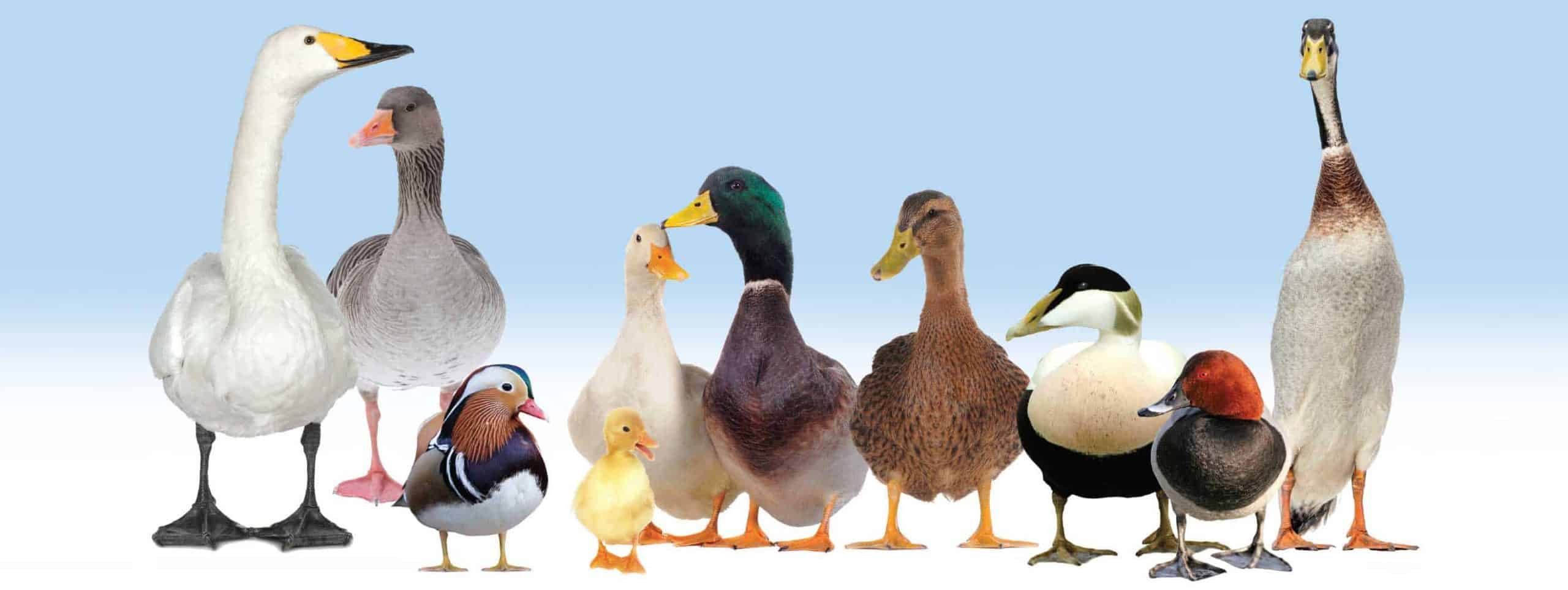Pond Location
The ideal site for a collection of wildfowl is probably a fairly extensive garden with natural running water. Waterfowl enjoy basking in the sunshine, but appreciate shelter from strong winds. Because ducks in particular spend a lot of time on the water, a sunny and sheltered position for their pond is favoured.
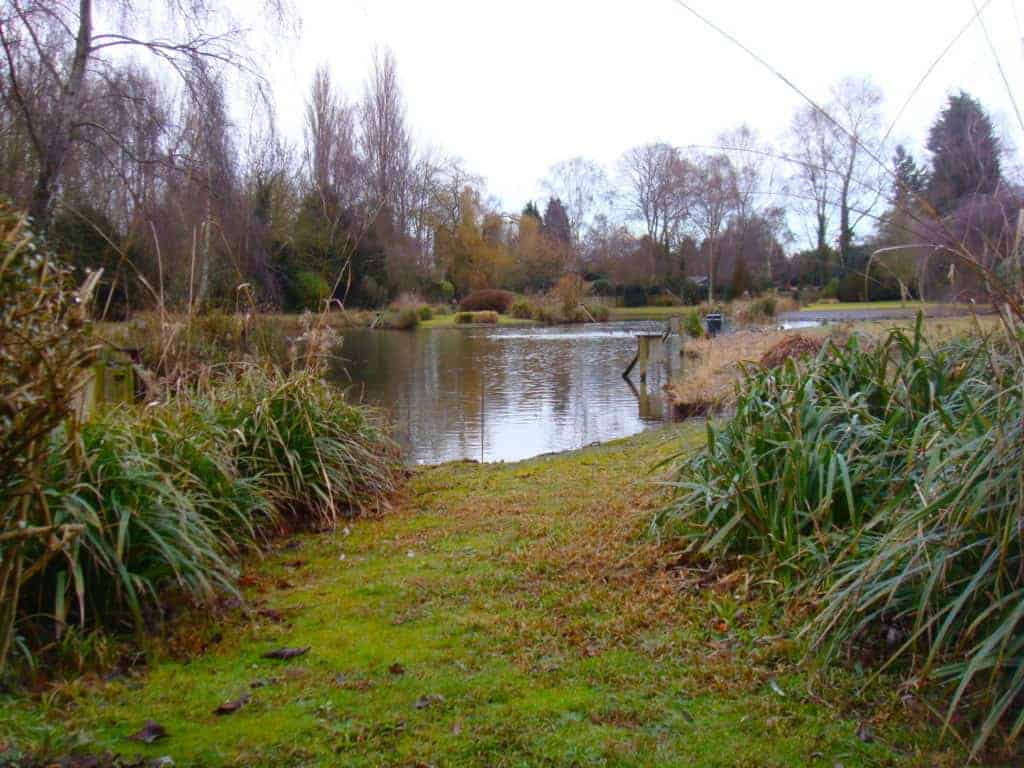
Ideally, a pond should not be sited under trees where falling leaves can sink and accumulate, as they will rot. Leaves that do fall should be removed by skimming before they sink. Willow is very attractive, it comes in many forms, but sadly there are problems associated with willow leaves: Cladosporum spp. of mould that lives on willow trees can affect feather quality.
If a pond can also be seen from one of your windows then all the better. The word ‘paddlinge’ is a medieval collective noun and describes a pool on which ducks, presumably domestic, were kept to help calm the life of the keeper. Our distant forbears surely recognised the therapeutic quality of waterfowl on a pond, viewed from their living space.
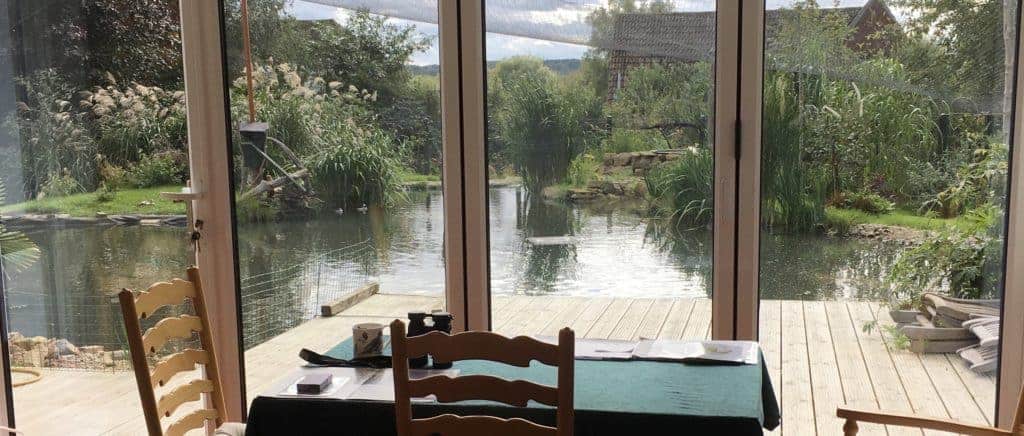
Natural Ponds
A pond is usually preferable to a river or a stream so that water levels can be maintained. An ’off-stream impoundment’ can be made by diverting some water and returning it further downstream. Before interfering with a natural watercourse, or even pumping, it is advisable to consult the local Environmental Agency Office, as there are regulations in force concerning water abstraction and related activities. The water level flowing out of a pond, possibly between a series of ponds, can be controlled by the use of a ‘monk’; a construction which is used mainly on fish farms since it enables the water level to be lowered relatively easily. The water normally falls over the top of the monk and is led away through an outlet pipe either to a lower pond or a series of ponds. Removal of the front boards leads to rapid lowering of the water level when pond maintenance or dredging is required, or if fish are to be caught! Where there is a neglected existing pond it should be dredged as deeply as possible for diving ducks, with shallower areas for the dabblers. A natural pond does not require any lining, but it is frequently desirable to protect the edges from erosion since the feet and constantly probing bills of wildfowl can be very destructive.
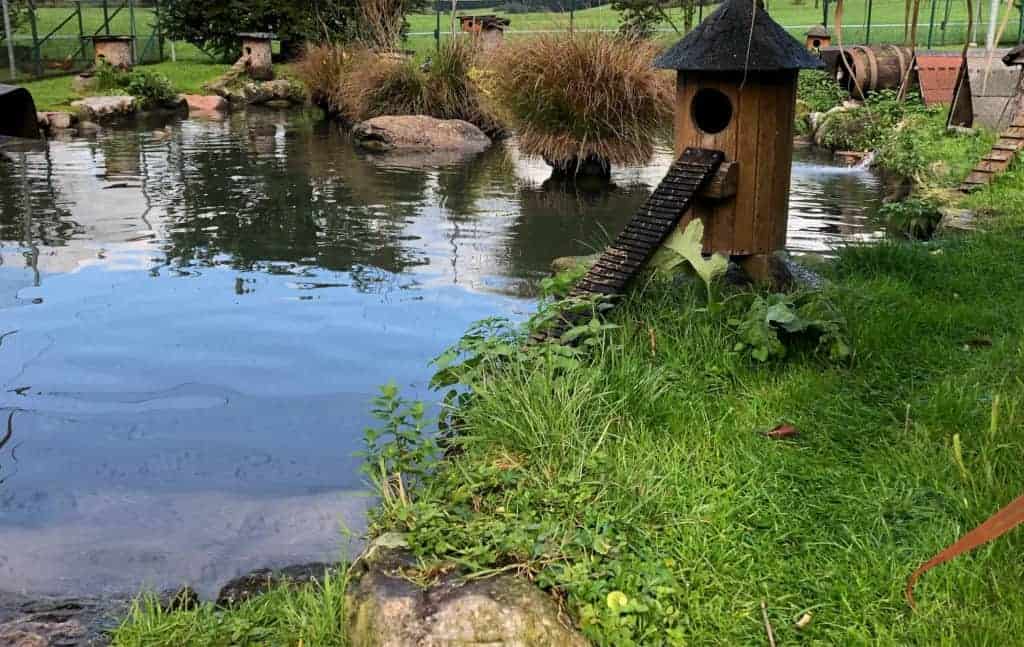
Rough concrete, or carefully laid stones can form a permanent protection to banks, but all crevices should be sealed. Ducks in particular have a dangerous and sometimes fatal habit of dabbling in holes and cracks and getting their heads wedged so that they drown or are strangled.
Soft edges will need protecting. Heavyweight black nylon mesh (Nicospan or similar) could be staked alongside the banks as a protective barrier. In theory, vegetation grows through this revetment so that it becomes disguised, but in practice any leaves are frequently eaten or mutilated as soon as they appear. However, it is possible to plant more substantial overhanging shrubs which droop and form a camouflage. Even hardy plants with woody stems are likely to require protection from inquisitive bills in the early stages of growth. Secure them with a circle of hard netting whilst they get established.
Artificial Ponds
If natural water is not available, satisfactory small ponds can be of fibreglass (GRP) or concrete or lined with butyl. GRP is relatively expensive and is generally only readily available in very small sizes. It can be formed on-site though as a custom installation.
Concrete is renowned for its permanence so long as it is thick enough – at least 4 inches is recommended. If possible, the base should be laid a few days before the sides, and the joins should be rendered watertight with a proprietary bonding or sealing compound. Rearing pools can be constructed out of concrete blocks and waterproofed using swimming pool products.
Pond liners are an area where you usually get what you pay for. Top of the range is heaviest gauge of butyl. Thought should always be given to how birds will get out of the pond, even if water levels drop a bit for any reason. Edges of the liner will be constantly scratched by sharp claws. It will also degrade in sunlight if exposed. An overhanging edge of paving slabs not only screens the top of the butyl from the human eye, but it also protects it from damage as the waterfowl scramble ashore. There are black underlays available which can be used to hide edges, with time some grasses may grow into them if your stocking density is not too high. A properly installed and cared for liner should have a life expectancy of at least ten years, often more with butyl.
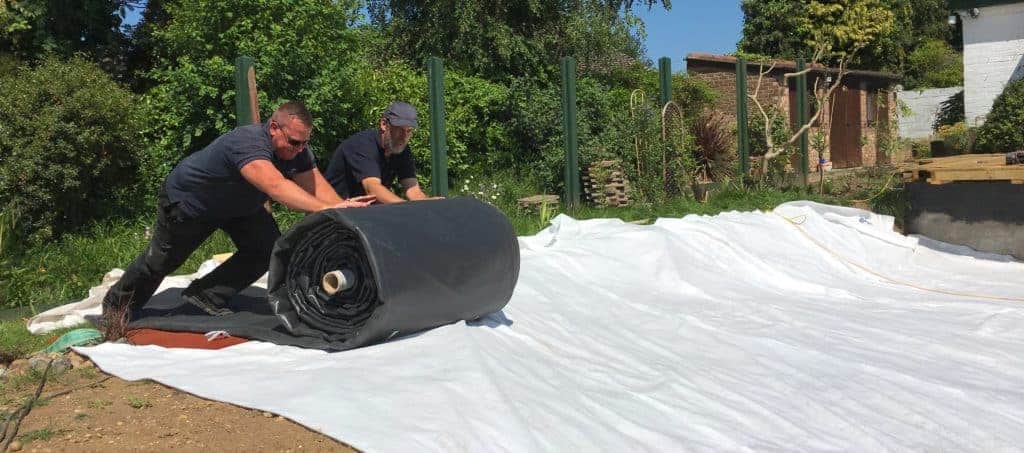
Where any liner is installed, a flat protected surface at the lowest point is worth designing in. Mechanical pumps are heavy and generally need to remain upright when in operation. Consider how you will get them in and out of the water, and how you will provide power.
Water Maintenance
The greater the depth of an artificial pond, the easier the maintenance, because sediment settles to the bottom. This sediment is only disturbed if divers are present. On the other hand, when you do empty it out the job is a much bigger one. The water must be kept clean so that the birds’ plumage stays in good order and so that the eye and nose of the keeper are not offended. A soak-away can readily be incorporated in a concrete pond: if a pipe, of at least 75 cm in diameter, with a threaded end is placed through the lowest point of the base, the cap can be unscrewed and the entire contents allowed to drain away. The removal of the cap can be an unpleasant chore but with a little practice it can be achieved without the operator’s arm being immersed in a black, smelly and sometimes cold, solution for too long a period. Thereafter, vigorous agitation with a broom should ensure that the solid particles disappear down the pipe, along with the liquid. The more enterprising entrepreneur will install a release mechanism which can be operated from above water level. A vertical tube projecting a few inches above the level of the water is ideal.
Small ponds can be emptied by bailing out with a bucket. This can be quite a strenuous exercise if an appreciable amount of water is involved. Siphoning can be done but this is usually too slow a process and semi-solids get left behind. Pumping is therefore most practical but care must be taken to ensure that sediment does not block the mechanism. Agitation will mix the solids with the liquid so that the pump can cope. A sewage pump designed to cope with such solids does the job well, and the black muck can be pumped straight onto nearby grass. The smell dissipates after a few days and the turf will recover and appreciate the feed.
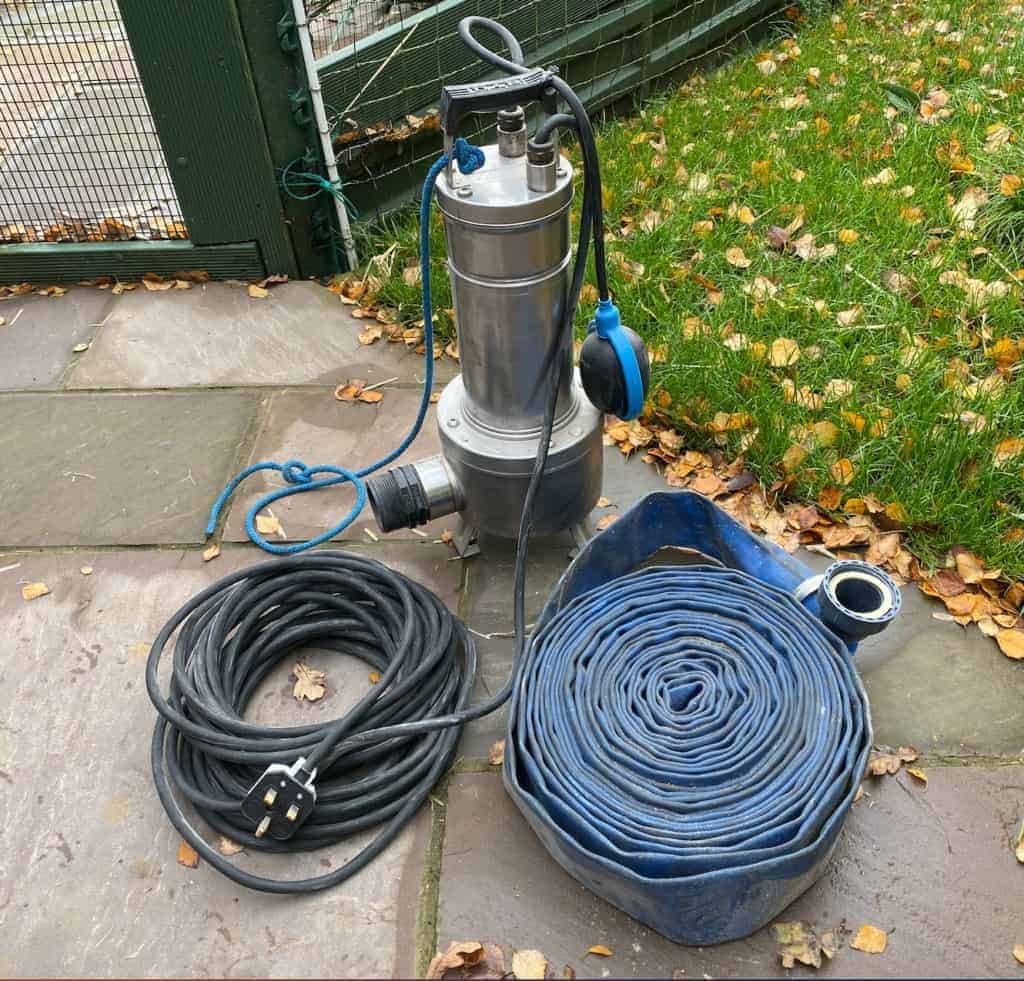
Waterfowl are at risk when a newly emptied pond is refilled. This is usually a slow process. The birds will want to return to the water as soon as they can. If the sides of the pond are steep, they will have difficulty in getting ashore until the water has returned to its natural level. The once-happy swimmers may wish to leave the water whilst the level is still low and during their frantic attempts to escape, they may become exhausted and perish. A temporary fence, erected around the pond until it has refilled, will avoid potential disaster. A raft in the pond, on which the birds can perch, will provide refuge until dry land is again accessible.
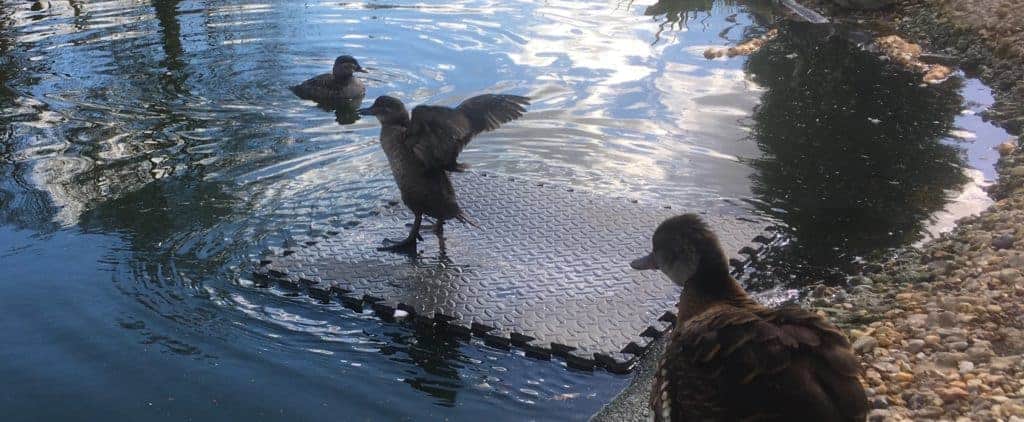
Rafts and Islands
Rafts and islands can be interesting and welcome features on all but the smallest ponds. Boards, say one inch thick, can be secured together with battens to form a floating island which serves as an admirable roost.
Buoyancy can be maintained by the fixing of partially filled plastic containers on the underside so that they are hidden from view. If the buoyancy is adjusted so the water overlaps the surface from time to time, for example when several ducks are roosting simultaneously, their weight lowers the raft and droppings are washed off.
A well-designed island is a tremendous asset for a collection of wildfowl in captivity. The banks on islands need to be protected even more than the shoreline, as you will not have such easy access for maintenance. Whether left natural or judiciously landscaped, the birds will benefit from the seclusion and relative safety from certain predators that the vegetation and comparative isolation will provide. The birds can be encouraged to nest on an island by the provision of nest boxes and by allowing undergrowth to flourish, but if eggs are to be collected, accessibility must be borne in mind.
It is a myth that waterfowl are safe from foxes and rats when on islands. Rats are particularly good swimmers and the vixen will stop at nothing if she has cubs to feed. Read our page on Fencing.
Aviaries
One method of keeping wildfowl on a small scale is to house one or two pairs in an aviary. Mandarin, Carolinas and several species of teal such as Ringed and Blue-winged appear to adapt fairly readily to such confinement and an advantage is that they can be free-winged. The addition of small cage-birds can work as they don’t interfere with the ducks but careful choices on species need to be made. It is very important not to over-stock an aviary.
An aviary pool which is a metre in diameter and 30 cm deep should be adequate for one pair of ducks. If it takes the form of a concrete-lined depression, the water can be swept out almost daily without too much effort. The surrounding area must be pervious and topped with loose small stones, such as pebbles, so that the water can drain away. Ducks love to pick up and play with small pebbles around the pond. Some pebbles will be dropped into the water so care must be taken if emptying the pond through a drain in the base. It is advisable to have a cage over the plughole to stop birds being sucked away.
Shrubs can be planted in the aviary to provide some privacy. Check that your choice of plants doesn’t include anything poisonous, there’s a basic list of poisonous plants in the sidebar. Artificial boxes for cavity nesters are essential if breeding is contemplated. Aviary birds are safer from predators than when in an open enclosure and within such a sheltered environment breeding results are often very good. Choose your species with care. If birds do not settle in reasonably quickly and show signs of distress, perhaps you should consider swapping them with someone who has more space and keeping something more suitable yourself. Please read about our rights and responsibilities (also in the sidebar) as waterfowl keepers.


